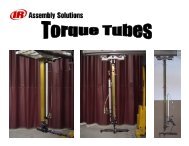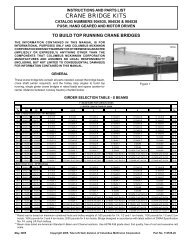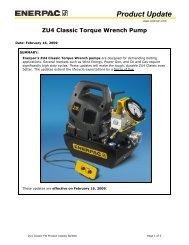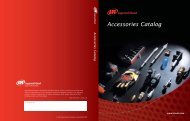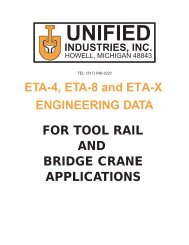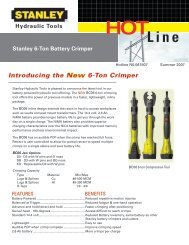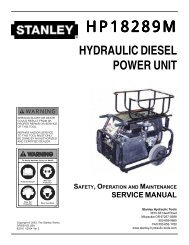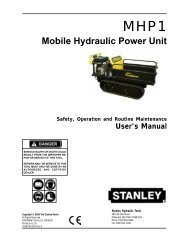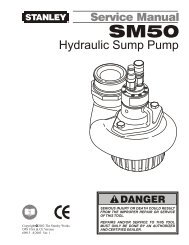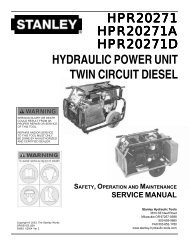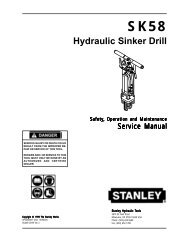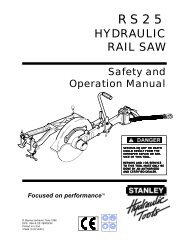MHD56209 Jib Cranes.pdf - ToolSmith
MHD56209 Jib Cranes.pdf - ToolSmith
MHD56209 Jib Cranes.pdf - ToolSmith
Create successful ePaper yourself
Turn your PDF publications into a flip-book with our unique Google optimized e-Paper software.
All new, altered or modified equipment should be inspected<br />
and tested by personnel instructed in safety, operation and<br />
maintenance of this equipment to ensure safe operation at<br />
rated specifications before placing equipment is service.<br />
Never use a unit that inspection indicates is damaged.<br />
Frequent and periodic inspections should be performed on<br />
equipment in regular service. Frequent inspections are visual<br />
examinations performed by operators or personnel trained in<br />
safety and operation of this equipment and include observations<br />
made during routine equipment operation. Periodic inspections are<br />
thorough inspections conducted by personnel trained in the safety,<br />
operation and maintenance of this equipment. Inspection intervals<br />
depend upon the nature of the critical components of the<br />
equipment and the severity of usage.<br />
Careful inspection on a regular basis will reveal potentially<br />
dangerous conditions while still in the early stages, allowing<br />
corrective action to be taken before the condition becomes<br />
dangerous.<br />
Deficiencies revealed through inspection, or noted during<br />
operation, must be reported to designated personnel instructed in<br />
safety, operation and maintenance of this equipment. A<br />
determination as to whether a condition constitutes a safety hazard<br />
must be decided, and the correction of noted safety hazards<br />
accomplished and documented by written report before placing<br />
the equipment in service.<br />
Records and Reports<br />
Inspection records, listing all points requiring periodic inspection<br />
should be maintained for all load bearing equipment. Written<br />
reports, based on severity of service, should be made on the<br />
condition of critical parts as a method of documenting periodic<br />
inspections. These reports should be dated, signed by the person<br />
who performed the inspection, and kept on file where they are<br />
readily available for authorized review.<br />
Frequent Inspections<br />
For equipment in continuous service, frequent inspections should<br />
be made by operators at the beginning of each shift.<br />
1. OPERATION. Check <strong>Jib</strong> Crane for full range of motion,<br />
smooth operation and ease of movement. Locate the source<br />
of any binding or rough operation and repair.<br />
2. THREADED CONNECTIONS. Check all threaded<br />
connections for tightness. Tighten if loose or replace if<br />
damaged.<br />
3. MOUNTING. If any loose or missing hardware is detected,<br />
tighten or replace.<br />
INSPECTION<br />
4. AIR SYSTEM. Visually inspect all connections, fittings,<br />
hoses and components for indication of air leaks. Repair any<br />
leaks or damage, tighten any loose connections.<br />
5. ELECTRICAL SYSTEM. Visually inspect all connections<br />
and components for indication of damage or loose<br />
connections. Shut off and disconnect power prior to<br />
removing inspection covers, repairing any damage or<br />
tightening connections.<br />
Periodic Inspection<br />
Frequency of periodic inspection depends on the severity of usage:<br />
NORMAL HEAVY SEVERE<br />
yearly semiannually quarterly<br />
Disassembly may be required for HEAVY or SEVERE usage.<br />
Keep accumulative written records of periodic inspections to<br />
provide a basis for continuing evaluation.<br />
Inspect all the items in “Frequent Inspection” on page 14. Also<br />
inspect the following:<br />
1. FASTENERS. Check all cotter pins, capscrews and nuts.<br />
Replace if missing or tighten if loose.<br />
2. ALL COMPONENTS. Inspect for wear, damage,<br />
deterioration, deformation and cleanliness. If external<br />
evidence indicates the need, disassemble. Check bearings,<br />
rollers, and plates. Replace worn or damaged parts. Clean,<br />
lubricate and reassemble.<br />
3. PIVOT ASSEMBLY. Inspect pivoting connections for<br />
looseness, bearing wear, and smooth operation. Repair or<br />
replace any loose or worn components.<br />
4. SUPPORTING STRUCTURE. Check for distortion, wear<br />
and continued ability to support load.<br />
5. LABELS AND TAGS. Check for presence and legibility of<br />
labels. Replace if damaged or missing.<br />
6. HANDLING DEVICE. Inspect in accordance with<br />
recommendations in manufacturers Parts, Operation and<br />
Maintenance manual.<br />
Units Not in Regular Use<br />
1. Units which have been idle for a period of one month or<br />
more, but less than one year, should be given an inspection<br />
conforming with the requirements of “Frequent Inspection”<br />
on page 14 prior to being placed into service.<br />
2. Unitswhichhavebeenidleforaperiodofmorethanoneyear<br />
should be given an inspection conforming with the<br />
requirements of “Periodic Inspection” on page 14 prior to<br />
being placed into service.<br />
3. Standby units should be inspected at least semiannually in<br />
accordance with the requirements of “Frequent Inspection”<br />
on page 14. In abnormal operating conditions, units should be<br />
inspected at shorter intervals.<br />
14 <strong>MHD56209</strong> - Edition 2



